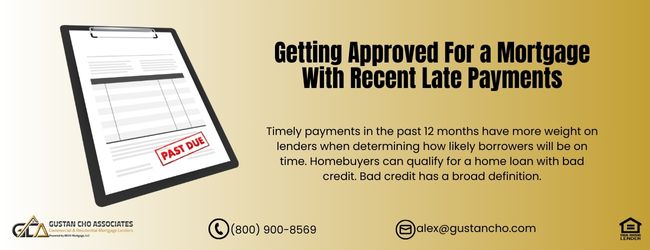Refinancing Guidelines With Bad Credit and Late Payments

This article covers late payment refinancing guidelines in the past twelve months. Mortgage rates have been skyrocketing since the beginning of 2025. Rates have skyrocketed to the highest level in the past 36 months. Lenders normally require timely payments in the past twelve months. The Federal Reserve Board has announced it will keep increasing interest rates. An interest rate increase by the Fed means higher mortgage rates. Mortgage rates have been the highest since the 2008 Great Recession and the real estate collapse in late 2024. Most homeowners who closed their home loans in 2018 have low rates in the 3.0% range. Homeowners must meet general refinancing guidelines, which differ depending on the loan program. In the following paragraphs, we will cover refinancing guidelines.
Refinancing Guidelines on Net Tangible Benefits
Most homeowners refinance their current mortgages to lower their monthly housing payments. Homeowners achieve this by refinancing their current mortgage with a new home loan that offers a lower mortgage rate. Refinancing their mortgage to a lower-rate loan can save homeowners tens of thousands of dollars throughout a 30-year fixed-rate mortgage. However, there are other reasons why homeowners need to refinance. John Strange, a senior mortgage loan officer at GCA Forums Mortgage Group, says the following about refinancing guidelines:
Here are other reasons homeowners need to refinance their loans besides lowering their mortgage rates. Refinancing is necessary to remove non-occupant co-borrowers. Due to divorce, they must take the ex-spouse off the mortgage note. Homeowners with equity in their homes may need to do a cash-out refinance.
If a parent dies, the lender takes over the property to cover the costs of a reverse mortgage. A land contract is due, which requires obtaining either a traditional government loan or a conventional loan. Borrowers are refinancing from a non-QM loan to a traditional one and converting an adjustable-rate mortgage to a fixed-rate one.
Refinancing Guidelines With Bad Credit and Late Payments
Refinancing a loan can be a powerful tool to lower monthly payments, reduce interest rates, or shorten the loan term. However, refinancing with bad credit and a history of late payments can present a significant challenge. While it’s not impossible, it requires careful planning, research, and realistic expectations. This comprehensive guide explores the challenges, requirements, and strategies for refinancing when your credit score is less than stellar and your payment history includes late payments.
Understanding Refinancing Guidelines and Its Challenges
Refinancing involves replacing an existing loan with a new one to secure better terms, such as a lower interest rate or a more manageable payment schedule. Refinancing is challenging for individuals with bad credit (typically a credit score below 580 on the FICO scale) and late payments because lenders view these factors as indicators of higher risk. Late payments, especially those reported to credit bureaus (typically 30 days or more past due), can significantly damage your credit score and signal financial instability to lenders.
Refinancing Guidelines: Key Challenges:
- Higher Interest Rates: Lenders may offer loans with higher rates to offset the perceived risk.
- Limited Lender Options: Traditional lenders like banks may decline applications, pushing borrowers toward subprime lenders.
- Stricter Eligibility Criteria: Lenders may require higher income, lower debt-to-income (DTI) ratios, or additional collateral.
- Impact of Late Payments: Recent late payments (within the last 12 months) can weigh heavily on approval decisions.
Despite these hurdles, refinancing is still possible with the right approach. Let’s dive into the guidelines and strategies to improve your chances.
Refinancing Guidelines With Bad Credit and Late Payments
Before applying for refinancing, take a close look at your finances:
- Check Your Credit Score: Visit AnnualCreditReport.com for a free credit report from Experian, Equifax, or TransUnion.
- Identify errors or inaccuracies that could be lowering your score.
- Review Late Payments: Determine the recency and frequency of late payments.
- Payments over 30, 60, or 90 days late are particularly damaging, but older late payments (over 12–24 months) may have less impact.
- Calculate Your DTI Ratio: Divide your total monthly debt payments by your gross monthly income.
- Lenders prefer a DTI below 43%, though some accept higher ratios for bad credit borrowers.
- Evaluate Equity (for Homeowners): If you are refinancing a mortgage, check your home’s equity (current value minus remaining mortgage balance).
- Significant equity can improve your approval odds.
Explore Refinancing Guidelines Lender Options
Not all lenders have the same criteria. Consider these options:
- FHA Loans: The Federal Housing Administration (FHA) offers refinancing programs with more lenient credit requirements.
- For example, the FHA Streamline Refinance sometimes requires a credit score as low as 500.
- However, late payments within the last 12 months may require an explanation.
- Subprime Lenders:
- These lenders specialize in high-risk borrowers but often charge higher interest rates and fees.
- Research reputable subprime lenders and compare terms.
- Credit Unions: Some credit unions offer flexible refinancing options for members with bad credit, especially if you have a history with them.
- Online Lenders: Platforms like Upstart or LendingPoint may use alternative data (e.g., employment history) to assess eligibility, offering options for those with poor credit.
Refinancing Guidelines: Improve Your Approval Odds
While bad credit and late payments limit options, you can take steps to make your application more appealing:
- Please provide a letter of explanation. If late payments were due to extenuating circumstances (e.g., medical emergencies, job loss), please write a concise letter to explain the situation to lenders.
- Increase Your Down Payment or Collateral: Offering a larger down payment or additional collateral can reduce lender risk for auto or mortgage refinancing.
- Add a Co-Signer: A co-signer with excellent credit can strengthen your application. However, they’ll be responsible if you miss payments.
- Pay Down Debt: Reducing credit card balances or other debts can improve your DTI ratio and credit score.
- Wait for Older Late Payments: If your late payments are recent, waiting 12-24 months can lessen their impact, as lenders prioritize recent payment history.
Understand Lender Requirements on Refinancing Guidelines
Lenders typically evaluate the following when considering refinancing for bad credit borrowers:
- Minimum Credit Score: Some lenders accept scores as low as 500-580, but terms may be less favorable.
- Payment History: Lenders scrutinize recent late payments (within 12 months).
- Some lenders may require 6–12 months of on-time payments before approval.
- Income Stability: Proof of steady income (e.g., pay stubs and tax returns) is critical to demonstrate repayment ability.
- Loan-to-Value (LTV) Ratio: A lower LTV (indicating more equity) can offset mortgage or auto refinancing credit concerns.
- Debt-to-Income Ratio: A DTI below 43% is ideal, though some lenders may accept up to 50% for bad credit borrowers.
Consider Government-Backed Programs
Government-backed refinancing programs can be a lifeline for those with inadequate credit.
- FHA Streamline Refinance: Requires an existing FHA loan and minimal credit checks.
- If you’ve made recent payments on time, the system may overlook late payments.
The VA Interest Rate Reduction Refinance Loan (IRRRL) is designed to help veterans refinance their existing loans.
This program has lenient credit requirements for veterans with VA loans.
- USDA Streamline Refinance: This program offers simplified refinancing with flexible credit guidelines for USDA loan holders in rural areas.
Refinancing Guidelines with Bad Credit: Be Prepared for Higher Costs
Refinancing guidelines with bad credit often come with trade-offs:
- Higher Interest Rates: Rates are 1–3 % higher than those for borrowers with good credit.
- Fees and Closing Costs: Expect origination fees, appraisal fees, or other costs, especially for mortgages.
- Could you ask lenders for a breakdown to avoid surprises?
- Longer Loan Terms: Extending the loan term can lower monthly payments but increase the total interest paid.
Refinancing Guidelines: Strategies to Improve Your Credit
Should refinancing not be immediately feasible, please consider taking steps to enhance your credit and payment history:
- Make On-Time Payments: Consistent on-time payments for 6–12 months can significantly boost your credit score.
- Reduce Credit Utilization: Keep credit card balances below 30% of your credit limit to improve your score.
- Correct Credit Report Errors: Dispute inaccuracies on your credit report through Experian, Equifax, or TransUnion.
- Avoid New Credit Applications: Multiple hard inquiries can further lower your score.
Alternatives to Refinancing
If refinancing isn’t viable, consider these alternatives:
- Loan Modification: Work with your current lender to modify loan terms, such as reducing the interest rate or extending the term.
- Debt Consolidation: This process involves combining multiple debts into a single loan that has a lower monthly payment; however, interest rates may still be high if you have bad credit.
- Budget Adjustments: Cut unnecessary expenses to free up funds for loan payments, reducing the need to refinance.
Refinancing Guidelines: Tips for Success
- Shop Around: Compare offers from at least three lenders to find the best terms.
- Read the Fine Print: Watch for prepayment penalties or high fees that could offset refinancing benefits.
- Consult a Financial Advisor: A professional can help you weigh the pros and cons based on your situation.
- Be Realistic: Refinancing with bad credit may not yield ideal terms, so ensure the new loan aligns with your financial goals.
- Refinancing guidelines with inadequate credit and late payments are challenging but achievable with the right approach.
- By understanding lender requirements, exploring government-backed programs, and understanding your financial profile, you can increase your chances of securing a refinance that works for you.
- While the process may involve higher costs and limited options, careful planning and persistence can lead to better loan terms and financial relief.
Always compare offers, review terms carefully, and consider consulting a financial expert to ensure refinancing aligns with your long-term goals. Late payments and inadequate credit are difficult to refinance. Still, it is doable when there is the right strategy. Understanding what lenders need, government programs available, and personal finances can help to work towards a refinance that works. Although there will be limited options and increased costs, better loan terms can always be available with a well-thought-out plan. Regardless of the situation, having the offer to compare will always be beneficial. Paying close attention to the terms and having a financial expert for guidance will ensure a successful decision regarding long-term goals. Most of the time, the situation necessitates consolidation and enhancement; an appraisal is not necessary.
VA And FHA Refinancing Guidelines With Bad Credit
VA and HUD refinancing guidelines allow streamlined refinance mortgages. VA and FHA loans have a streamlined refinance mortgage program without requiring an appraisal or income documents. Borrowers with an FHA or VA loan can do an FHA and VA Streamline Refinance with limited documentation. The only requirement is that they have been on time with their current loan for the past 12 months.
Borrowers can have late payments on any other credit tradelines except for their mortgage. One 30-day late payment in the past 12 months is allowed. Streamlines often close in two to three weeks.
Per VA and HUD refinancing guidelines, no appraisal is required. No income documents are required. Credit scores are used to price out mortgage rates. The higher the borrower’s credit scores, the lower the mortgage rates. There is no cost to streamlining. Borrowers often get to skip one or two monthly mortgage payments after they streamline.
Mortgage Late Payment Refinancing Guidelines In The Past 12 Months
Lenders allow prior bad credit when qualifying borrowers for a mortgage. Borrowers can have late payments, collections, charged-off accounts, prior bankruptcy, or housing events. However, per the automated underwriting system (AUS), borrowers have needed timely payments in the past 12 months to get approval/eligibility.
One or two late payments in the past 12 months are not always a deal-killer. Multiple late payments in the past 12 months are often a deal-killer
Lenders understand borrowers may have had extenuating circumstances in the past. The key question is whether there have been timely payments in the past 12 months. However, lenders need to see that borrowers have re-established themselves and have been timely in the past 12 months.
Refinancing Guidelines Qualifying For Mortgage With Late Payments In The Past 12 Months
Borrowers who have made late payments in the past 12 months can qualify for a mortgage with non-QM loans. There is no waiting period after bankruptcy, foreclosure, deed-in-lieu of foreclosure, or short sale with non-QM loans. Private mortgage insurance is not required with non-QM loans. There is no maximum loan limit. A 10% to 20% down payment is required.
Non-QM mortgage rates are higher than those of government and conventional loans. However, non-QM mortgage loans have lenient lending requirements compared to traditional loans. Non-QM loans can be used as bridge loans for borrowers with late payments in the past 12 months.
Borrowers can refinance their non-QM loans to a traditional mortgage with lower rates and terms once they have been timely and reestablished their credit. For more information about the content of this article or other mortgage-related topics, please contact us at GCA Forums Mortgage Group at 800-900-8569 or text us for a faster response. Or email us at gcho@gustancho.com.






Responses